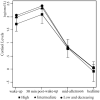Childhood Trajectories of Hyperactivity/Inattention Symptoms and Diurnal Cortisol in Middle Adolescence: Results from a UK Birth Cohort
- PMID: 34378439
- PMCID: PMC8859655
- DOI: 10.1177/10870547211036755
Childhood Trajectories of Hyperactivity/Inattention Symptoms and Diurnal Cortisol in Middle Adolescence: Results from a UK Birth Cohort
Abstract
Objective: Children with attention-deficit/hyperactivity disorder (ADHD) show hypoactivity of the hypothalamic-pituitary-adrenal (HPA) axis. Whether the association between hyperactivity/inattention symptoms with HPA axis dysfunction holds in the general child population too is not clear.
Method: We assessed associations between longitudinal trajectories of hyperactivity/inattention symptoms during ages 4 to 13 years and basal cortisol profiles at age 15 in a British general population cohort.
Results: Adolescents with persistently high levels of hyperactivity/inattention symptoms since childhood showed lower total morning cortisol and a smaller diurnal decline, even after adjusting for confounders. No associations were found between any of the symptom trajectories and cortisol awakening response, diurnal slope or daily output of cortisol.
Conclusion: This study provides evidence for hypocortisolism among adolescents with chronic hyperactivity/inattention symptoms in the general population.
Keywords: ALSPAC; adolescence; childhood; cortisol; hyperactivity/inattention.
Conflict of interest statement
Figures
Similar articles
-
The role of inflammatory markers and cortisol in the association between early social cognition abilities and later internalising or externalising problems: Evidence from a UK birth cohort.Brain Behav Immun. 2022 Oct;105:225-236. doi: 10.1016/j.bbi.2022.07.002. Epub 2022 Jul 11. Brain Behav Immun. 2022. PMID: 35835432
-
Altered hypothalamus-pituitary-adrenal axis function: A relevant factor in the comorbidity of atopic eczema and attention deficit/hyperactivity disorder?Psychoneuroendocrinology. 2019 Jul;105:178-186. doi: 10.1016/j.psyneuen.2018.12.005. Epub 2018 Dec 6. Psychoneuroendocrinology. 2019. PMID: 30583940
-
Stress-related biomarkers and cognitive functioning in adolescents with ADHD: Effect of childhood maltreatment.J Psychiatr Res. 2022 May;149:217-225. doi: 10.1016/j.jpsychires.2022.02.041. Epub 2022 Mar 2. J Psychiatr Res. 2022. PMID: 35287052
-
Cortisol, inflammatory biomarkers and neurotrophins in children and adolescents with attention deficit hyperactivity disorder (ADHD) in Taiwan.Brain Behav Immun. 2020 Aug;88:105-113. doi: 10.1016/j.bbi.2020.05.017. Epub 2020 May 8. Brain Behav Immun. 2020. PMID: 32418647
-
Hypothalamic-pituitary-adrenocortical axis function in attention-deficit hyperactivity disorder.Curr Top Behav Neurosci. 2012;9:93-111. doi: 10.1007/7854_2010_101. Curr Top Behav Neurosci. 2012. PMID: 22231898 Review.
Cited by
-
Temperament Dimensions and Awakening Cortisol Levels in Attention-Deficit/Hyperactivity Disorder.Front Psychiatry. 2022 Apr 25;13:803001. doi: 10.3389/fpsyt.2022.803001. eCollection 2022. Front Psychiatry. 2022. PMID: 35546956 Free PMC article.
-
ADHD symptoms and diurnal cortisol in adolescents: The importance of comorbidities.Psychoneuroendocrinology. 2023 Feb;148:105990. doi: 10.1016/j.psyneuen.2022.105990. Epub 2022 Nov 26. Psychoneuroendocrinology. 2023. PMID: 36462296 Free PMC article.
-
A bidirectional Mendelian randomization study about the role of morning plasma cortisol in attention deficit hyperactivity disorder.Front Psychiatry. 2023 Jun 14;14:1148759. doi: 10.3389/fpsyt.2023.1148759. eCollection 2023. Front Psychiatry. 2023. PMID: 37389173 Free PMC article.
References
-
- Adam E. K., Quinn M. E., Tavernier R., McQuillan M. T., Dahlke K. A., Gilbert K. E. (2017). Diurnal cortisol slopes and mental and physical health outcomes: A systematic review and meta-analysis. Psychoneuroendocrinology, 83, 25–41. https://dx.doi.org/10.1016%2Fj.psyneuen.2017.05.018 - PMC - PubMed
-
- Agnew-Blais J. C., Polanczyk G. V., Danese A., Wertz J., Moffitt T. E., Arseneault L. (2018). Young adult mental health and functional outcomes among individuals with remitted, persistent and late-onset ADHD. The British Journal of Psychiatry, 213(3), 526–534. 10.1192/bjp.2018.97 - DOI - PMC - PubMed
-
- Anda R. F., Felitti V. J., Bremner J. D., Walker J. D., Whitfield C., Perry B. D., Dube S. R., Giles W. H. (2006). The enduring effects of abuse and related adverse experiences in childhood. A convergence of evidence from neurobiology and epidemiology. European Archives of Psychiatry and Clinical Neuroscience, 256(3), 174–186. 10.1007/s00406-005-0624-4 - DOI - PMC - PubMed
Publication types
MeSH terms
Substances
Grants and funding
LinkOut - more resources
Full Text Sources
Medical



